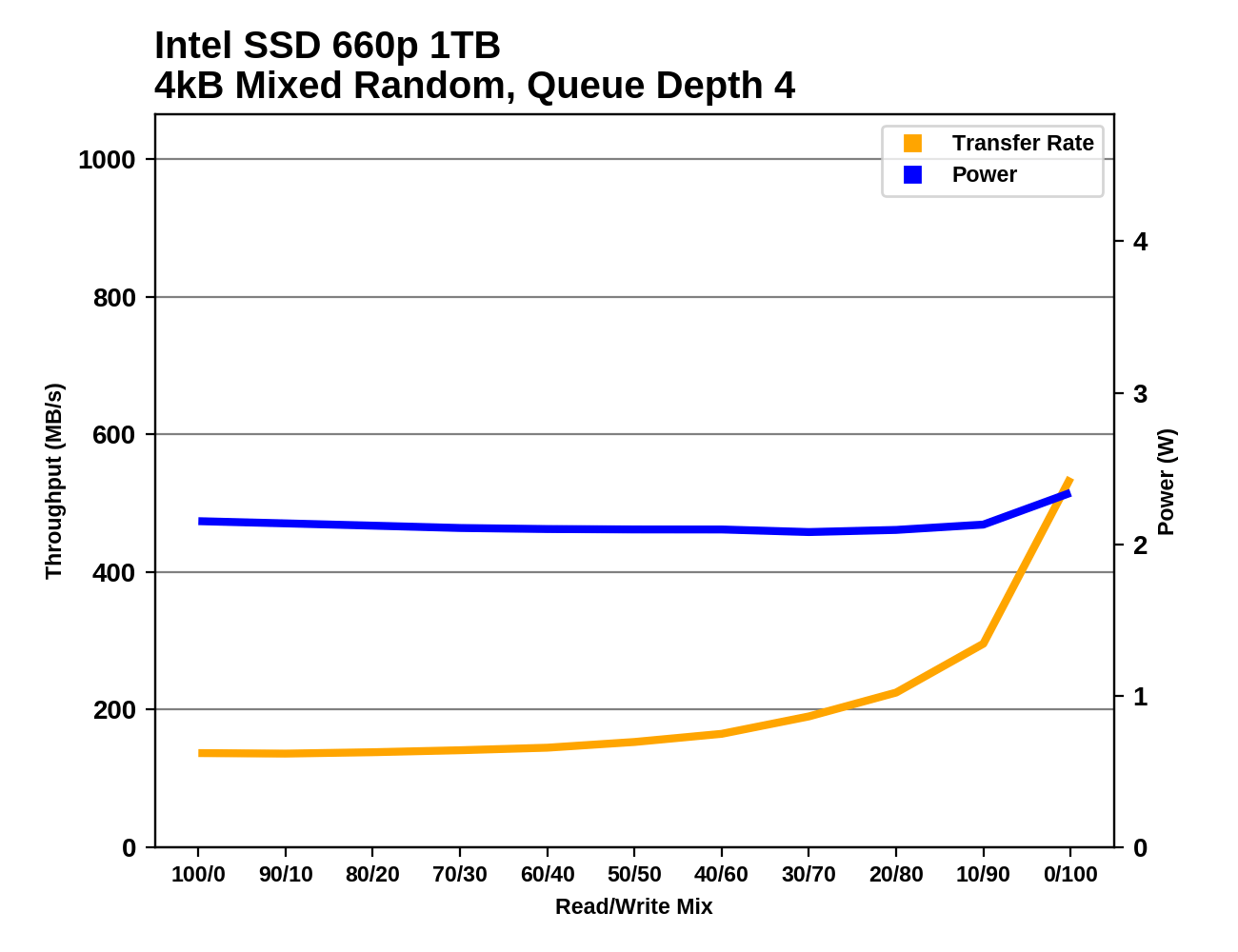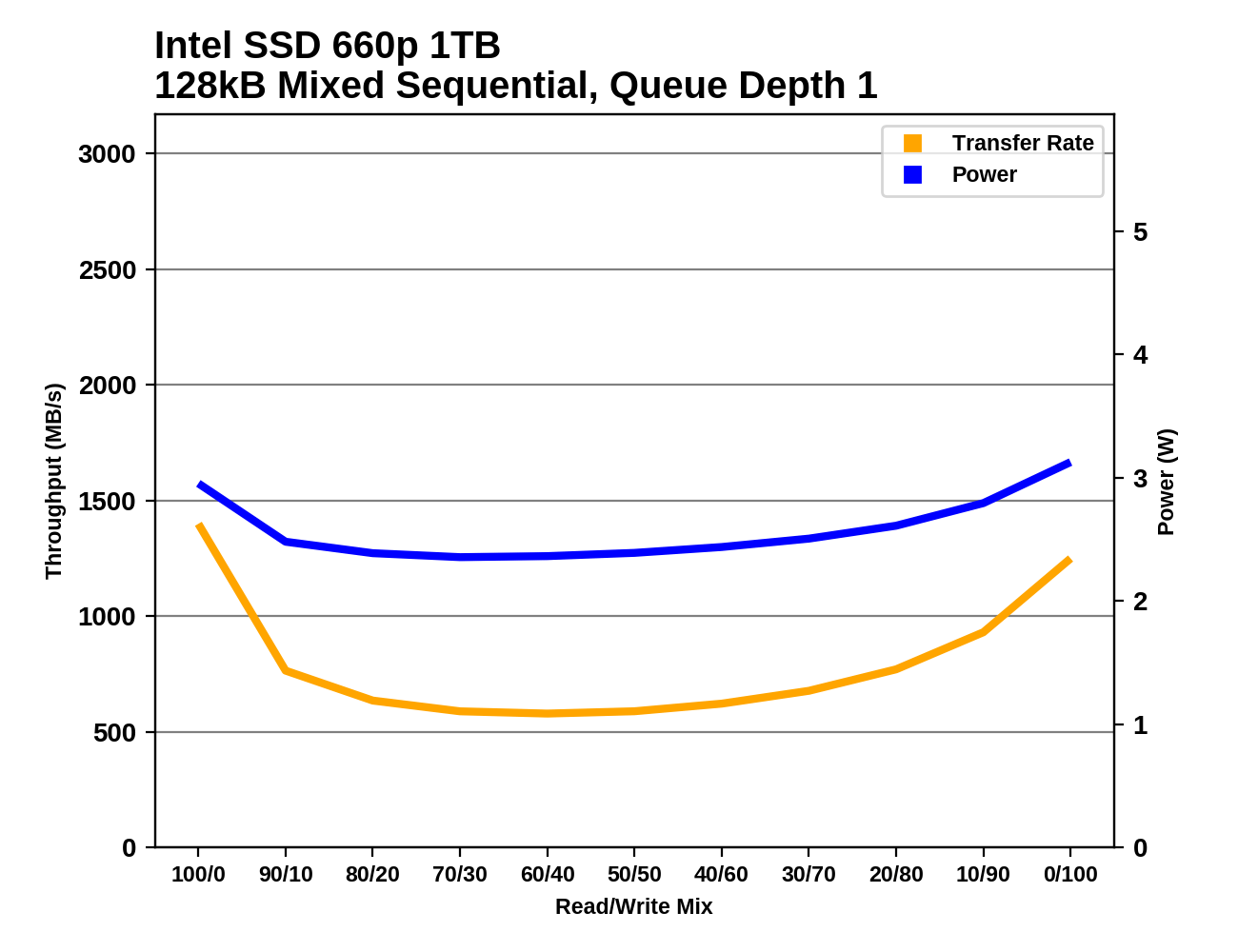The Intel SSD 660p SSD Review: QLC NAND Arrives For Consumer SSDs
by Billy Tallis on August 7, 2018 11:00 AM ESTMixed Random Performance
Our test of mixed random reads and writes covers mixes varying from pure reads to pure writes at 10% increments. Each mix is tested for up to 1 minute or 32GB of data transferred. The test is conducted with a queue depth of 4, and is limited to a 64GB span of the drive. In between each mix, the drive is given idle time of up to one minute so that the overall duty cycle is 50%.

The mixed random I/O performance of the Intel SSD 660p is clearly above the other low-end NVMe drives we've tested, or the Crucial MX500 SATA drive. It scores closer to a mid-range NVMe SSD. After filling the drive, performance is cut in half, leaving it performing near low-end NVMe drives like the Phison E8-based Kingston A1000 and below the MX500.
 |
|||||||||
| Power Efficiency in MB/s/W | Average Power in W | ||||||||
The power efficiency of the 660p during the mixed random I/O test is unimpressive but doesn't stand out as being significantly worse that other low-end NVMe drives even when the test is run on a full drive.
 |
|||||||||
The Intel SSD 660p shows very slow performance growth throughout most of the test, but it picks up speed reasonably well toward the end as the workload shifts toward pure writes, and the SLC cache handles things well. When the drive is full, the reduced capacity of the SLC cache prevents speed from increasing much.
Mixed Sequential Performance
Our test of mixed sequential reads and writes differs from the mixed random I/O test by performing 128kB sequential accesses rather than 4kB accesses at random locations, and the sequential test is conducted at queue depth 1. The range of mixes tested is the same, and the timing and limits on data transfers are also the same as above.

The Intel SSD 660p performs better than other entry-level NVMe SSDs or SATA drives when the mixed sequential I/O test is run on a mostly empty drive with a large SLC cache. After the drive is filled, performance drops down to slightly ahead of the 600p and Crucial MX500.
 |
|||||||||
| Power Efficiency in MB/s/W | Average Power in W | ||||||||
The power efficiency of the Intel SSD 660p during the mixed sequential I/O test is decent when operating entirely out of the SLC cache, and on par with most other low-end NVMe drives when the 660p is full.
 |
|||||||||
When the test is run on a mostly-empty 660p the performance shows a very typical bathtub curve and no sign of the SLC cache running out. When the drive is full, performance decreases steadily as the proportion of writes increases.










86 Comments
View All Comments
dromoxen - Friday, August 10, 2018 - link
You would hope these things would have even larger dram buffers than tlc. I will pass on these 1st gen and stick with with HD.Has intel stopped making ssd controllers?
To do some tests , write endurance, why not cool down the m.2 nand to LN2 temps, I'm sure debauer has some pots and equipment. I expect these will be even cheaper by jan 19
tomatotree - Tuesday, August 14, 2018 - link
Intel makes their own controllers for all their enterprise drives, and all 3DXP drives, but for consumer NAND drives they use 3rd party controllers with customized firmware.As for LN2 cooling, what would that show? That the drive might fail if you use it in a temperature range way out of spec?
351Cleveland - Monday, August 20, 2018 - link
I’m confused. Why would I buy this over, say, an MX500 (my default go-to)? This thing is a dog in every way. How can Anandtech recommend something they admit is flawed?icebox - Thursday, December 6, 2018 - link
I don't understand why everybody fusses about retention and endurance so much. Do you really buy ssd's to leave them on a shelf for months or years? Retention ? If it dies during warranty you exchange it. If it dies after it then it's probably slow and small in comparison with what's available than.You do have backups, right? Because no review or test or battery of tests won't guarantee that *your drive* won't die.
BTW that's the only way I saw ssd's die - it works perfectly and after a reboot it's gone, not detected by the system.
icebox - Thursday, December 6, 2018 - link
The day has come when choosing storage is 4 tiered.You have fast nvme, slow nvme, sata ssd's and traditional hdd's. At least I kicked hdd's off my desktop. I have a samsung nvme for boot and applications and sata ssd's for media and photos. Now I'm looking of replacing those with the 2tb 660p and moving those to the nas for bulk storage.
southleft - Tuesday, May 14, 2019 - link
It would be very helpful if the review would show just how full the drive can be before performance degrades significantly. Clearly, when the drive is "full" its performance sucks, but can we expect good performance when the drive is half-full, two-thirds full, three-quarters full? C'mo, Anandtech, tell us something USEFUL here!boozed - Monday, December 30, 2019 - link
There's something wrong with the 970 EVO's results on page 3. Full performance exceeds empty performance. This is not reflected in the 970 EVO review.